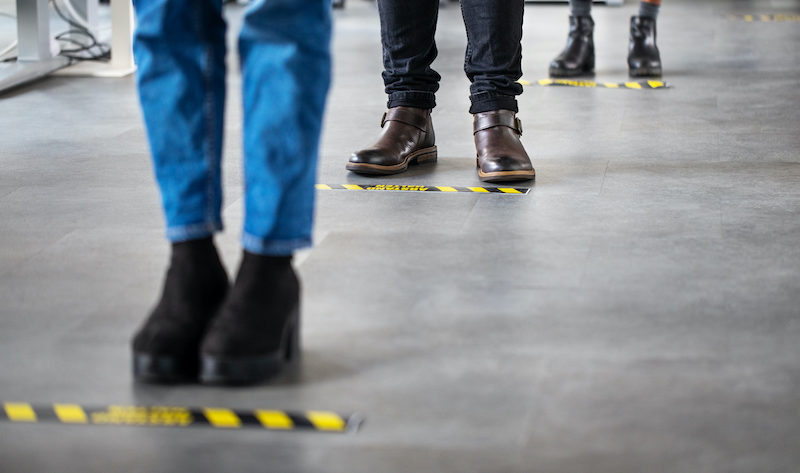
Native communities have responded to the pandemic in fast-moving, expertise-driven, and innovative ways.
Tribes have faced overwhelming challenges in responding to the COVID-19 pandemic: underfunded health care; aging populations; multigenerational households; high burdens of chronic disease and preexisting conditions; and uncertainty about the scope of tribal regulatory powers.
In turn, Indigenous people have experienced a disproportionate share of illness, suffering, and death. COVID-19 has been calamitous for many tribes, whether through depriving them permanently of tribal elders’ linguistic and cultural knowledge or through pushing already precarious communities deeper into poverty.
But tribes have not simply been passive witnesses to COVID-19’s devastation. Even while mourning losses, many tribes have succeeded in mitigating the pandemic’s harm through aggressive, creative, and timely governmental responses.
One example is the widely praised response of the Cherokee Nation, which as of November 2020 had suffered a relatively low 33 deaths among its 140,000 citizens while keeping schools open and in-person. Another example is the highly efficient vaccination campaign by Alaska Native tribes—a major contributor to Alaska’s first-in-nation status in vaccine distribution.
Even when a lack of resources or hostility from surrounding states hampered tribal mitigation measures, tribal actions likely bought time and averted worst-case scenarios.
Although each of the 574 federally recognized—and hundreds more unrecognized—tribes in the United States has had a different COVID-19 experience, three qualities that characterize strong tribal responses stand out: Most of these tribes acted quickly, embraced expertise while tailoring measures to specific community qualities and needs, and engaged in necessary innovation.
Effective tribal responses to COVID-19 were early and proactive. Throughout the United States, leaders at the federal, state, and local level were often slow to recognize the threat COVID-19 posed and to take action even after the risks were clear. By contrast, even in the pandemic’s early days, many tribal leaders recognized that the danger COVID-19 presented was real and significant.
Indigenous people in the United States have long suffered disproportionately from infectious disease. Tribal history has been marked by viral devastation, including the lasting trauma from the viruses spread by colonizers in the 18th century as well as the more recent experience of the 1918 influenza pandemic. Furthermore, the particular risk COVID-19 poses to older people had the potential to be catastrophic for many tribes for whom tribal elders provide a vital link to Indigenous languages, culture, and history.
Given these concerns, many tribes took action aggressively and quickly. In early March, long before COVID-19 reached Indian country to any meaningful extent, many tribes were planning for the inevitable and working proactively to develop a response. Tribes were early adopters of curfews, stay-at-home orders, and mask mandates—adopting such policies often well before the states in which they were located took similar actions. And although some nontribal communities have recently begun widespread COVID-19 testing, some tribes instituted vigorous testing programs much earlier. Some tribes have led the way in vaccination as well, both participating in clinical trials and establishing effective channels of supply and distribution.
Tribes have adapted expertise to community needs and norms. Tribes have generally shown a willingness to embrace expert opinion—again in contrast to the state and local context, where public officials have faced unprecedented attacks for implementing data-driven public health measures. The Cherokee Nation’s Principal Chief—who has joked that he has “several Dr. Faucis” advising him—described the Nation’s approach to the pandemic and explained that the Nation would “defer to the expertise of our public health staff to let them do what they do best.”
In addition to heeding homegrown expertise, tribes have also “worked around-the-clock” to best make use of the help that federal officials offered—taking advantage of the government-to-government relationship to secure personal protective equipment, set up contact tracing, and obtain access to vaccines.
At the same time, tribes have implemented expert advice that takes account of particular local conditions. The Cheyenne River Lakota Nation, for example, set a minimum age of 16 for grocery shopping after finding that children under that age did not reliably abide by health precautions such as social distancing.
Reflecting societal values, many tribes have taken especially stringent measures to protect elders, including a system of color-coded window signs that a tribal public health agency in Maine devised to allow elders to seek help without leaving home. Heeding widespread advice that quarantine and isolation facilities could help contain outbreaks, some tribes repurposed casinos to this end as well.
Tribes have embraced innovation in their pandemic response measures. Tribes have consistently pioneered novel measures to combat COVID-19, developing new and creative solutions to urgent problems, including some of the few successful border control programs in the United States. Several tribes instituted checkpoints to monitor travel, helping to delay the introduction of the virus to their reservation. The Picuris Pueblo, a small and aging tribe, likewise instituted a rapid-testing program at the border for anyone entering tribal lands.
Innovation has also helped tribes weather broader pandemic challenges. For example, the Lower Brule Sioux Tribe built its own wireless network to provide remote education to children in households lacking internet access. The Poarch Band of Creek Indians retooled a tribal defense production factory to manufacture personal protective equipment.
Tribes have also developed inventive methods for obtaining and increasing uptake of COVID-19 vaccines. In Alaska—which leads the United States in percentage of its population vaccinated— one-third of those vaccinated are among the Alaska Native population. Alaska Native tribes have used charter planes, sleds, and a water taxi to achieve impressive vaccination goals in remote areas. Notably, many other states that are vaccine success stories—such as Oklahoma, North and South Dakota, and New Mexico—also are home to tribes that have worked actively to vaccinate their members.
Tribes have worked tirelessly and quickly not only to obtain vaccination supplies—in some cases, switching to partnerships with the federal government when state allocations were sluggish—but also to overcome challenges with distribution and vaccine hesitancy. To address members’ fears about the vaccine, various tribes have put on puppet shows, broadcasted Zoom interviews with tribal elders and health care practitioners, and, in the case of the Flandreau Santee, engaged mental health professionals to provide support and reassurance to each tribe member receiving the vaccine.
Tribes face distinct challenges in governance and regulation, not least the legal doctrines that—even in the midst of a pandemic—hinder tribes’ ability to apply their own laws to nonmembers. At the same time, tribal governments often have the advantage of being nimbler and more responsive to community needs than governments outside Indian country.
* * *
During the COVID-19 pandemic, the fast-moving actions of tribal governments—coupled with the urgency born of the traumatic, historical experience of infectious disease in Indian country—created the conditions for an effective tribal response. Although not always beyond criticism nor enough to overcome poverty, state resistance, and other constraints, effective tribal governance has both saved lives in Indian country and provided a model of pandemic response outside it.
This essay is part of a series entitled Native Peoples, Tribal Sovereignty, and Regulation.




